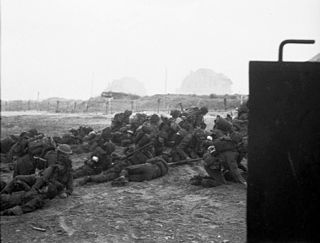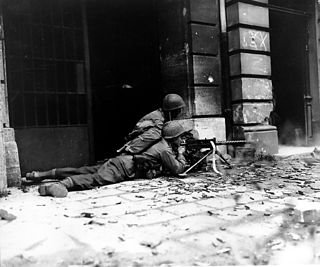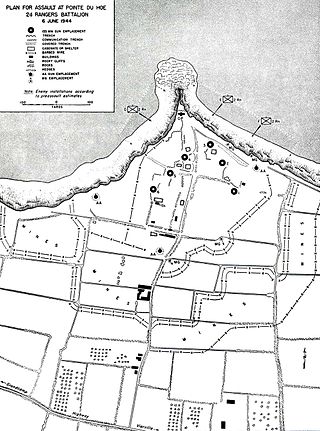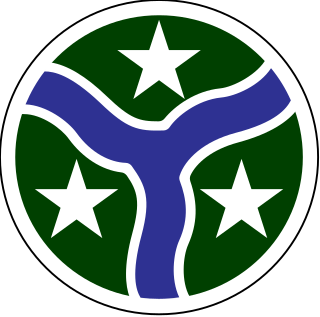
Juno and or Juno Beach was one of five beaches of the Allied invasion of German-occupied France in the Normandy landings on 6 June 1944 during the Second World War. The beach spanned from Courseulles, a village just east of the British beach Gold, to Saint-Aubin-sur-Mer, and just west of the British beach Sword. Taking Juno was the responsibility of the First Canadian Army, with sea transport, mine sweeping, and a naval bombardment force provided by the Royal Canadian Navy and the British Royal Navy as well as elements from the Free French, Norwegian, and other Allied navies. The objectives of the 3rd Canadian Infantry Division on D-Day were to cut the Caen-Bayeux road, seize the Carpiquet airport west of Caen, and form a link between the two British beaches on either flank.

Omaha Beach was one of five beach landing sectors of the amphibious assault component of Operation Overlord during the Second World War.

Sword, commonly known as Sword Beach, was the code name given to one of the five main landing areas along the Normandy coast during the initial assault phase, Operation Neptune, of Operation Overlord. The Allied invasion of German-occupied France commenced on 6 June 1944. Stretching 8 kilometres (5.0 mi) from Ouistreham to Saint-Aubin-sur-Mer, the beach proved to be the easternmost landing site of the invasion after the abortion of an attack on a sixth beach, code-named Band. Taking Sword was to be the responsibility of the British Army with sea transport, mine sweeping and a naval bombardment force provided by the British Royal Navy as well as elements from the Polish, Norwegian and other Allied navies.

The Battle of Aachen was a battle of World War II, fought by American and German forces in and around Aachen, Germany, between 12 September and 21 October 1944. The city had been incorporated into the Siegfried Line, the main defensive network on Germany's western border; the Allies had hoped to capture it quickly and advance into the industrialized Ruhr Basin. Although most of Aachen's civilian population was evacuated before the battle began, much of the city was destroyed and both sides suffered heavy losses.

The 8th Armored Division was an armored division of the United States Army that served in the European Theater of World War II.

The 14th Armored Division was an armored division of the United States Army assigned to the Seventh Army of the Sixth Army Group during World War II. It remains on the permanent roll of the Regular Army as an inactive division, and is eligible for reactivation. The division is officially nicknamed the "Liberators".

Gold, commonly known as Gold Beach, was the code name for one of the five areas of the Allied invasion of German-occupied France in the Normandy landings on 6 June 1944, during the Second World War. Gold, the central of the five areas, was located between Port-en-Bessin on the west and the Lieu-dit La Rivière in Ver-sur-Mer on the east. High cliffs at the western end of the zone meant that the landings took place on the flat section between Le Hamel and La Rivière, in the sectors code-named Jig and King. Taking Gold was to be the responsibility of the British Army, with sea transport, mine sweeping, and a naval bombardment force provided by the Royal Navy as well as elements from the Dutch, Polish and other Allied navies.

La Pointe du Hoc is a promontory with a 35-metre (110 ft) cliff overlooking the English Channel on the northwestern coast of Normandy in the Calvados department, France.

The 3rd Canadian Division is a formation of the Canadian Army responsible for the command and mobilization of all army units in the provinces of Manitoba, Saskatchewan, Alberta and British Columbia, as well as all units extending westwards from the city of Thunder Bay.

The 278th Armored Cavalry Regiment, previously the 117th Infantry Regiment, is an armored brigade combat team of the Tennessee Army National Guard with headquarters in Knoxville, Tennessee. It is the only National Guard Armored Cavalry Regiment and one of only two in the entire US Army order of battle, the other being the active duty 11th ACR. The unit traces its lineage from the volunteer militias of Eastern Tennessee and has participated in conflicts from the Revolutionary War to the Global War on Terror.

The 30th Infantry Division was a unit of the Army National Guard in World War I and World War II. It was nicknamed the "Old Hickory" division, in honor of President Andrew Jackson. The Germans nicknamed this division "Roosevelt's SS". The 30th Infantry Division, involved in 282 days of intense combat over a period from June 1944 through April 1945, was regarded by a team of historians led by S.L.A. Marshall as the American infantry division that had "performed the most efficient and consistent battle services" in the European Theater of Operations (ETO). In the present day, the division's lineage continues as 30th Armored Brigade Combat Team, part of the North Carolina National Guard. The unit's most recent combat deployment was in 2019.

DD or duplex drive tanks, nicknamed "Donald Duck tanks", were a type of amphibious swimming tank developed by the British during the Second World War. The phrase is mostly used for the Duplex Drive variant of the M4 Sherman medium tank, that was used by the Western Allies during and after the Normandy Landings in June 1944.
The 741st Tank Battalion was an independent tank battalion that participated in the European Theater of Operations with the United States Army in World War II. The battalion participated in combat operations throughout northern Europe until V-E Day. It was one of five tank battalions that landed in Normandy on D-Day. It landed on Omaha Beach supporting the 1st Infantry Division, but was attached to 2d Infantry Division on 15 June 1944, which it supported for most of the remainder of the war. The battalion played a key role in blunting the northern flank of the German attack during the Battle of the Bulge in December 1944. The 741st Tank Battalion advanced as far as Plzeň, Czechoslovakia by the end of the war.

The 79th Armoured Division was a specialist armoured division of the British Army created during the Second World War. The division was created as part of the preparations for the Normandy invasion on 6 June 1944, D-Day.

The 11th Armoured Division was an armoured division of the British Army which was created in March 1941 during the Second World War. The division was formed in response to the unanticipated success of the German panzer divisions. The 11th Armoured was responsible for several major victories in the Battle of Normandy from in the summer of 1944, shortly after the Normandy landings, and it participated in the Allied advance from Paris to the Rhine, the Rhine crossing in March 1945. It was disbanded in January 1946 and reformed towards the end of 1950. In 1956, it was converted into the 4th Infantry Division.
The 70th Armor Regiment is an armored (tank) unit of the United States Army. It was constituted as the 70th Tank Battalion in July 1940, an independent tank battalion intended to provide close support to infantry units. In this role, it saw action in the Mediterranean and European Theater of Operations, making assault landings and fighting with the 9th Infantry Division in North Africa, and with the 1st Infantry Division in Sicily. The battalion supported the 4th Infantry Division on Utah Beach during the D-Day landings in France, and fought with the 4th Infantry Division through the remainder of World War II. The 70th Tank Battalion was one of the first three tank battalions to deploy to Korea in the Korean War, where it saw significant action, primarily with the 1st Cavalry Division.
The 3rd Shock Army was a field army of the Red Army formed during the Second World War. The "Shock" armies were created with the specific structure to engage and destroy significant enemy forces, and were reinforced with more armoured and artillery assets than other combined arms armies. Where necessary the Shock armies were reinforced with mechanised, tank, and cavalry units. During the Second World War, some Shock armies included armoured trains and air–sled equipped units.

The 747th Tank Battalion was an independent tank battalion that participated in the European Theater of Operations with the United States Army in World War II. It was credited with an assault landing at Normandy, landing the morning after the initial D-Day landings (D+1). The battalion participated in combat operations throughout northern Europe until V-E Day, primarily attached to the 29th Infantry Division. After the war it was briefly engaged in occupation duties. Redesignated the 747th Amphibian Tank Battalion on 10 July 1945, it was inactivated in March 1946.
The 30th Guards Rifle Division was reformed as an elite infantry division of the Red Army in May, 1942, based on the 1st formation of the 238th Rifle Division, and served in that role until after the end of the Great Patriotic War. It would soon after help provide the headquarters cadre for the 7th Guards Rifle Corps along with its "sister" 29th Guards Rifle Division. However, it was not assigned as a unit to the Corps until August when it joined 33rd Army of Western Front and saw extensive fighting, while also suffering extensive casualties, in the summer campaign against the German 3rd Panzer Army in the southern sector of the Rzhev salient. After leaving 7th Guards Corps the division was reassigned to several other armies in the Front until April, 1943 when it joined the 15th Guards Rifle Corps in 30th Army, which became 10th Guards Army the next month; it would remain under these commands for the duration of the war. The division took part in Operation Suvorov, Western Front's summer offensive towards Smolensk, and after the liberation of that city was involved in several unsuccessful drives on the Belarusian city of Orsha. By December the 30th Guards had been redeployed to 2nd Baltic Front and during the summer and fall of 1944 it took part in the offensives through the Baltic states, winning a battle honor for its part in the liberation of Riga. For the rest of the war the division remained in Latvia helping to contain the German forces trapped in the Courland Peninsula, eventually coming under command of Leningrad Front. In mid-1946 it was converted to the 30th Separate Guards Rifle Brigade.
The 85th Guards Rifle Division was reformed as an elite infantry division of the Red Army in April 1943, based on the 2nd formation of the 118th Rifle Division, and served in that role until after the end of the Great Patriotic War. Late during the conflict it became known as one of the "Latvian Guards" rifle divisions due to its role in the liberation of that state.
















